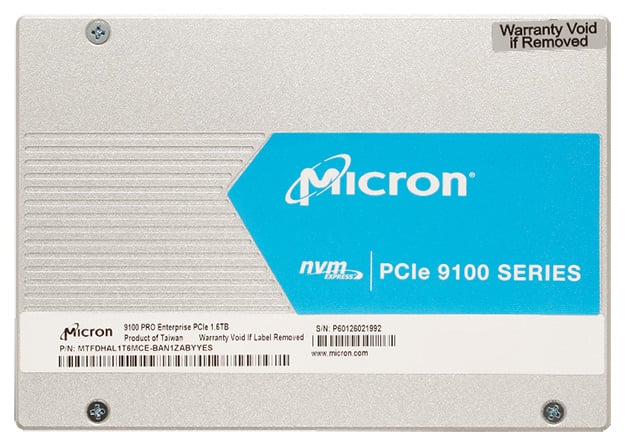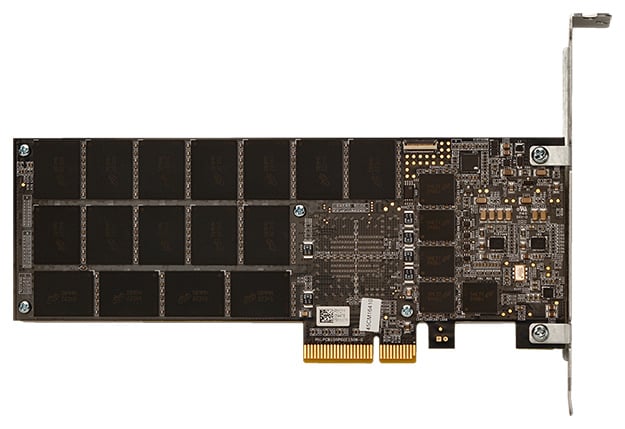Micron 9100 MAX NVMe PCIe Enterprise SSD Review
Introducing The Micron 9100 MAX NVMe SSD
Micron announced its 9100 Series NVMe enterprise-class solid state drive back in April. The drives come in multiple flavors and form factors, with the Micron 9100 PRO series targeting read-centric environments, while the 9100 MAX targets mixed-use cases. Capacities for the drives in the Micron 9100 series range from 800GB on up to 3.2TB, though all of the drives are outfitted with similar controllers and NAND.
Although news of the drives has been circulating for a couple of months now, it was just recently that we got our hands on one for some in-house testing. We’ve been experimenting with a Micron 9100 MAX 2.4TB HHHL NVMe drive for a couple of weeks and will detail its performance on the pages ahead. This particular drive is one of the higher-performing models in Micron’s line-up, and as you’ll see a little later, it is quite the speedster, especially in terms of write performance.
First up, we’ve got some specifications and additional information on Micron’s 9100 series SSD line-up, and then we’ll dig a little deeper into the 2.4TB 9100 MAX...
Micron’s 9100 series solid state drives will be available in U.2 and half-height / half-length, add-in card form factors. As we’ve mentioned, capacities range from 800GB on up to 3.2TB for the entire family and all drives feature 16nm MLC NAND flash memory. The performance characteristics of the drives vary based on capacity, due to the different number of NAND packages and channels utilized, and the amount of DRAM cache employed. The fastest of the bunch is the 2.4TB 9100 MAX drive, which tops out at over 3GB/s with up to 750,000 (read) / 300,000 (write) IOPS.
The 800GB, 1.6TB, and 3.2TB drives are the 9100 PRO models, which are designed for read heavy workloads. The 1.2TB and 2.4TB drives are tuned for mixed-use cases. Like performance, endurance also varies based on capacity. The 800GB drive is rated for up to 2.4PB (total bytes written), the 1.2TB and 1.6TB drives up to 4.8PB, and the 2.4TB and 3.2TB up to 9.6PB. All of the drives feature power-loss protection and Micron’s XPERT data path protection technologies, as well as TRIM and idle garbage collection as you’d expect.
The Micron 9100 series drives feature a PCI Express Gen 3 NVMe interface with a 16-core, 16-channel Microsemi controller and varying amounts of DRAM cache. The amount of NAND over-provisioned on the drives varies as well. The table below explains how much NAND and DRAM are used on each drive, along with other architecture details.

The 2.4TB Micron 9100 MAX drive actually has 4TB of raw NAND capacity, leaving 1.6TB over-provisioned for maintenance and other proprietary drive operations. The 2.4 and 3.2TB drives also have the most DRAM cache. We should also note that typical power consumption ranges from 7W (idle) on up to a max of 27W for the 3.2TB drive (load), though max power can be limited to 20W or 25W as well.
The Micron 9100 series solid state drives also come with 3-year warranties and are supported by Micron’s Storage Executive Software, which can be used to update the drives, monitor health status, and perform a number of maintenance operations.
Although news of the drives has been circulating for a couple of months now, it was just recently that we got our hands on one for some in-house testing. We’ve been experimenting with a Micron 9100 MAX 2.4TB HHHL NVMe drive for a couple of weeks and will detail its performance on the pages ahead. This particular drive is one of the higher-performing models in Micron’s line-up, and as you’ll see a little later, it is quite the speedster, especially in terms of write performance.
First up, we’ve got some specifications and additional information on Micron’s 9100 series SSD line-up, and then we’ll dig a little deeper into the 2.4TB 9100 MAX...
|
| U.2 | HHHL | |
| Capacity | 800GB, 1.2TB, 1.6TB, 2.4TB, 3.2TB | |
| Interface | PCIe Gen 3 NVMe | |
| Seq. Read / Write Performance |
800GB: 2.1GB/s / 650MB/s 1.2TB: 2.8GB/s / 1.3GB/s 1.6TB: 2.8GB/s / 1.3GB/s 2.4TB: 3.0GB/s / 2.0GB/s 3.2TB: 3.0GB/s / 2.0GB/s |
|
| Random Read / Write Performance | 800GB: 540,000 / 55,000 IOPS 1.2TB: 700,000 / 180,000 IOPS 1.6TB: 700,000 / 100,000 IOPS 2.4TB: 750,000 / 300,000 IOPS 3.2TB: 750,000 / 160,000 IOPS |
|
| Read / Write Latency | 120us / 30us | |
| Active Power Consumption | 800GB: 7-16W (TYP) 1.6TB, 1.2TB: 7-21W (TYP) 2.4TB, 3.2TB: 7-27W (TYP) Unlimited, 25W and 20W limiting available |
|
| Idle Power Consumption | 7W | |
| Operating Temp | 0'C to 85'C | |
| Dimensions | 100.5 x 69.85 x 15mm | 167.65 x 18.74 x 68.89mm |
| Power Loss Protection | Yes | |
| Extended Features | eXtended Performance and Enhanced Reliability Technology (XPERT) suite of performance and data protection algorithms | |
Micron’s 9100 series solid state drives will be available in U.2 and half-height / half-length, add-in card form factors. As we’ve mentioned, capacities range from 800GB on up to 3.2TB for the entire family and all drives feature 16nm MLC NAND flash memory. The performance characteristics of the drives vary based on capacity, due to the different number of NAND packages and channels utilized, and the amount of DRAM cache employed. The fastest of the bunch is the 2.4TB 9100 MAX drive, which tops out at over 3GB/s with up to 750,000 (read) / 300,000 (write) IOPS.
The 800GB, 1.6TB, and 3.2TB drives are the 9100 PRO models, which are designed for read heavy workloads. The 1.2TB and 2.4TB drives are tuned for mixed-use cases. Like performance, endurance also varies based on capacity. The 800GB drive is rated for up to 2.4PB (total bytes written), the 1.2TB and 1.6TB drives up to 4.8PB, and the 2.4TB and 3.2TB up to 9.6PB. All of the drives feature power-loss protection and Micron’s XPERT data path protection technologies, as well as TRIM and idle garbage collection as you’d expect.
The Micron 9100 series drives feature a PCI Express Gen 3 NVMe interface with a 16-core, 16-channel Microsemi controller and varying amounts of DRAM cache. The amount of NAND over-provisioned on the drives varies as well. The table below explains how much NAND and DRAM are used on each drive, along with other architecture details.

The Micron 9100 series solid state drives also come with 3-year warranties and are supported by Micron’s Storage Executive Software, which can be used to update the drives, monitor health status, and perform a number of maintenance operations.










